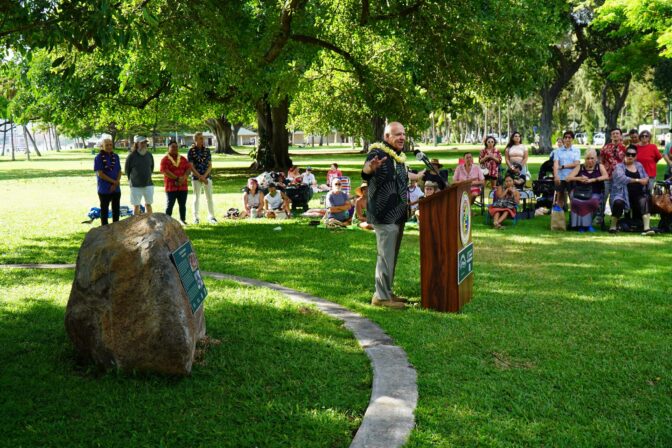By Staff Reports
(HONOLULU) – At a special ceremony in Waikīkī last week, Mayor Rick Blangiardi and members of Hawaiʻi’s LGBTQ+ Māhū community unveiled a new plaque to celebrate the legacy of Queen’s Surf Beach, which has been a meaningful location for members of that community for the past 50 years.
In 1974, Queen’s Surf Beach was the site of the first Pride celebration in Hawaiʻi and the area has been a popular gathering place for members of Hawaiʻi’s LGBTQ+ Māhū communities dating back to the beginning of the 1970s, where locals and visitors alike could meet, relax, and be themselves without fear of judgment or violence. Unlike most gay beaches of that era, Queen’s Surf was highly visible to the public, emblematic of Hawaiʻi’s generally more accepting environment. Hula dancers and lei makers, volleyball players and roller skaters, musclemen and beauty queens; all were welcome at Queen’s.
The plaque is now placed at the base of a tree at Queen’s Surf Beach. It is the newest in a series of physical and digital historical markers created by Lei Pua ʻAla Queer Histories of Hawaiʻi, a project to document and memorialize vital LGBTQ+ Māhū sites across Hawaiʻi’s multicultural landscape.
“We are proud to celebrate the importance and the significance of a renowned location like Queen’s Surf Beach because these are the places and the stories that make our island home special and unique,” said Mayor Rick Blangiardi. “But more than that, we are proud to be a supportive, welcoming, and loving City for all residents and visitors alike, regardless of their sexuality or gender.”
“The aim of our work is to make the lives and experiences of LGBTQ+ Māhū folks, who have always been part of Hawaiʻi’s story, more visible, because being seen and understood increases possibilities for being accepted and valued in the place you call home,” said Lei Pua ʻAla Queer Histories of Hawaiʻi co-director Joe Wilson.
The new Queen’s Surf Beach marker is intended to inspire current and future generations to reclaim and reactivate the beach, including The Māhūi, a group of young cultural advocates who are part of the Hawaiʻi LGBT Legacy Foundation.
“For decades, Queen’s Surf provided a safe space for fellowship, cultural activities, sports, and storytelling,” said Legacy Foundation Executive Director Randy Soriano. “To honor the history of this place, and connect generations of queer people, our Māhūi has centered monthly community gatherings and our annual Pride kick-off picnic at the site, recreating the energy that once regularly filled this beach.”
The historical marker consists of a plaque mounted on a large stone that was selected by master craftsman Keoni Mossman, who is connected to the site through his uncle Sterling Mossman, the so-called Hula Cop, who became famous for entertaining at the Barefoot Bar at Queen’s Surf in the 1950s and 60s. The Queen’s Surf Restaurant and Bar were demolished in 1972 to make way for a public beach.

